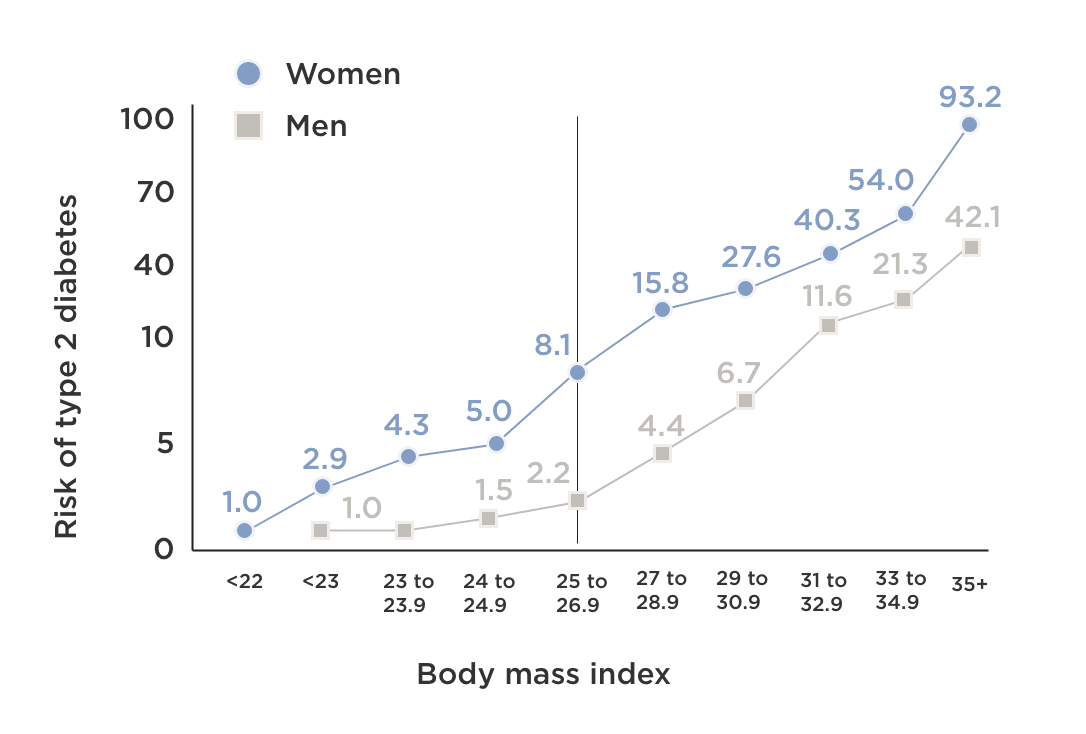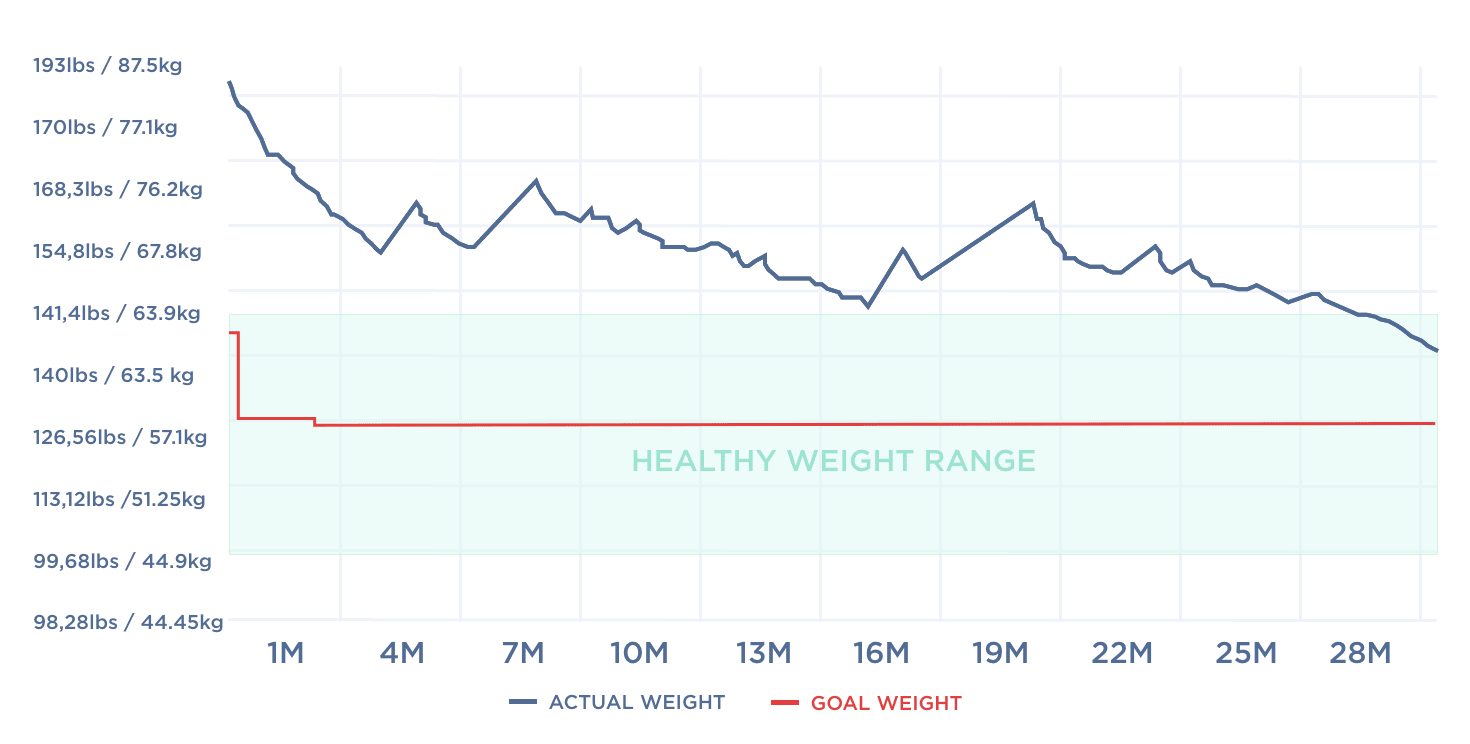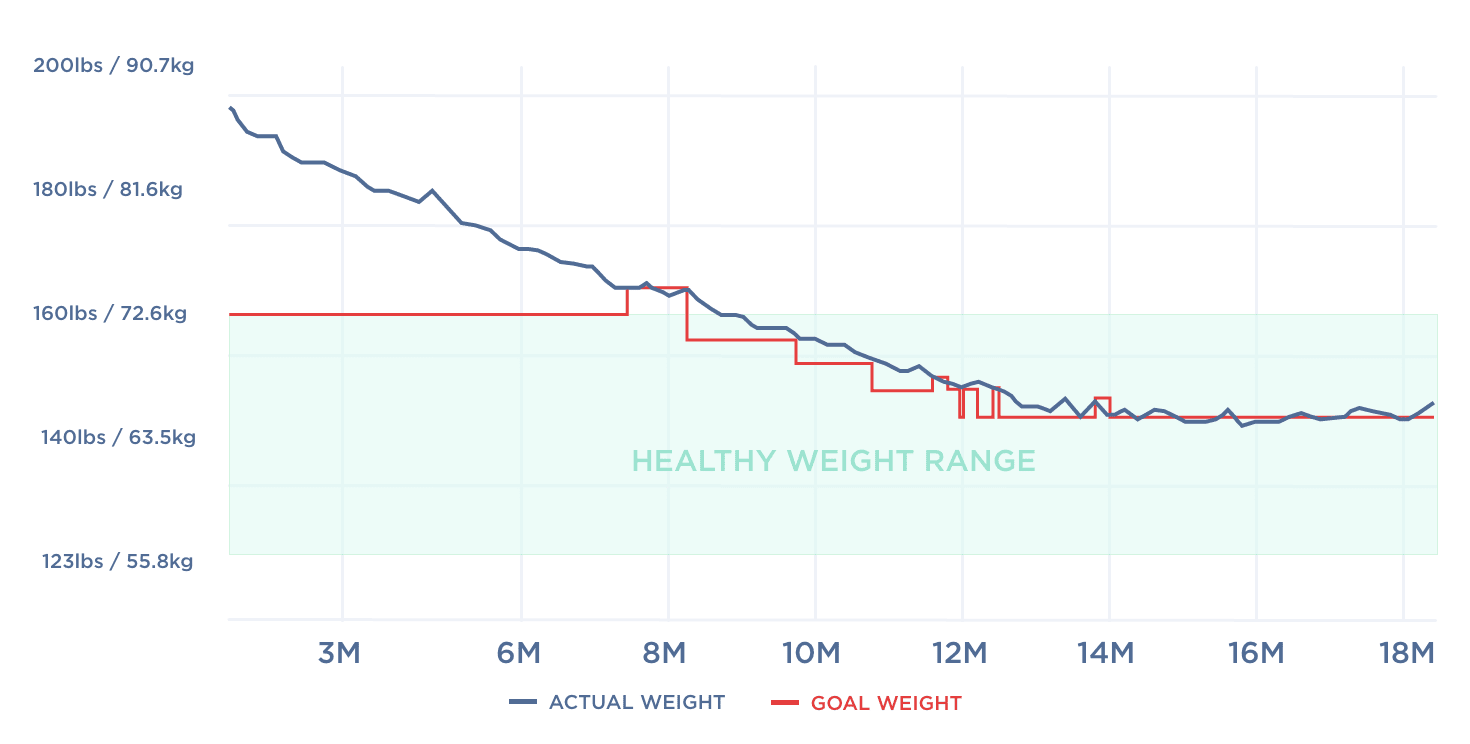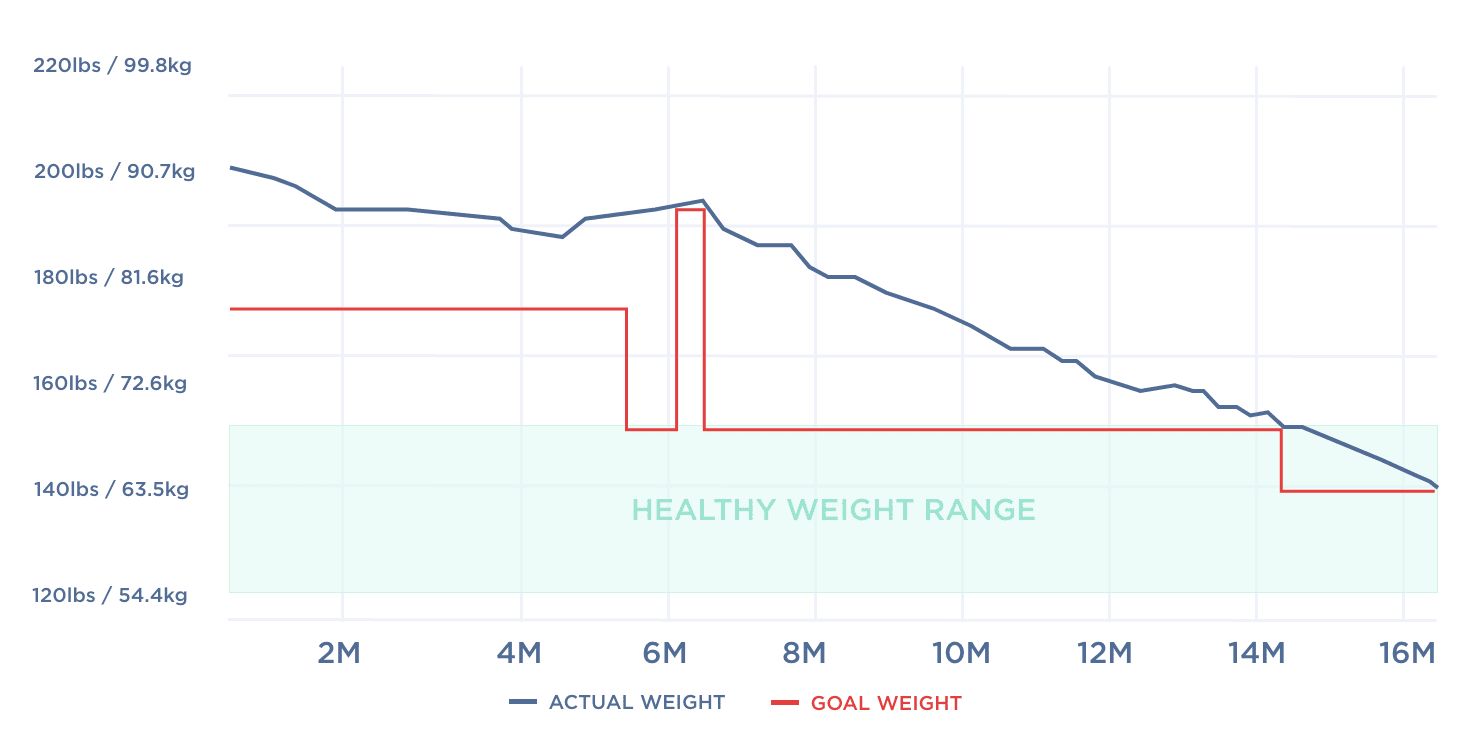
Fitness Watches for Men: Track Your Health & Performance
Explore our fitness watches for men by Withings. Monitor your activity, heart rate, and sleep with precision. These watches are designed...
Whether you want to lose weight or just to keep your weight off, accurate weight goals can help you turn your wishes into reality. However, not all weight goals are helpful, and setting an unrealistic target weight can even put you in danger.

Losing even 10 percent of excess weight can improve your health significantly, according to research. However, setting a weight goal can be more complex than it sounds.
Weight is often linked to a person's self-esteem, and the psychology of setting a weight goal should not be underestimated. A 2011 study, "Anticipated emotions and effort allocation in weight goal striving", states that:
“In line with predictions, we found that negative anticipated emotions towards goal non-attainment resulted in increased efforts but only if people perceived themselves in close proximity to their goal.”
People who intend to lose weight usually refer to losing body fat—but it is also important to go beyond weight and consider body composition and other factors that may affect their overall health.
Learn how to set weight goals you can actually achieve to improve your health. Make your weight loss journey SMART with some tips to stay at your target weight.
Setting a realistic weight goal can help you think about the short term as well as the big picture when it comes to reducing excess body fat.
Too often, we set large, unrealistic goals—in a 2001 study, University of Pennsylvania researchers found that obese patients set the most unrealistic weight goals, and were most often disappointed when they failed to reach them.
However, we found that Withings users with a target weight managed to lose more pounds than those who did not set a target weight. Setting a target weight is definitely a way to achieve greater results, faster.
Finally, setting a realistic weight goal is also a way to track how your metabolism reacts to lifestyle changes, whether they are controlled or unintentional.
These kinds of takeaways can help to prevent you from joining programs that seem too good to be true. Comparing your own weight target against these promises can help save you money.

The relationship between BMI and the risk of developing type 2 diabetes. Source: International Diabetes Federation
As shown in the graph above, there is a strong relationship between a higher body mass index (BMI) and developing type 2 diabetes in both men and women. By setting a weight goal, you can take action against a number of chronic diseases.
Thinking strategically about how to lose weight and creating a manageable plan can help you set yourself up for success.
Yes! A 2016 study in the Journal of Human Nutrition and Dietetics found that setting targets leads to greater long-term weight loss. “Although obese people were less likely to set targets, doing so increased the likelihood of achieving clinically significant weight loss and, for some ‘unrealistic’ targets, improved the results,” noted the researchers.
And joining a coaching program to keep you accountable may help. Multiple studies have suggested that health coaching programs, including virtual ones, may help to promote weight loss.
For example, a 2019 study found that weekly video conferencing may help to induce weight loss in obese individuals. A 2018 study in the American Journal of Health Promotion looked at goal-setting via a telephone coaching program and concluded that obese and overweight participants who set goals for weight management and increased physical activity achieved better results than those who set alternate goals.
First, and we cannot stress this enough: Ask your doctor. Your doctor will be able to take your health history into account, make personalized recommendations, and may be able to refer you to a nutritionist if needed.
Body fat percentage is not the same as Body Mass Index (BMI), which is often used as an indicator of your overall health based on your height and weight and doesn’t take your total body composition into account.
That said, keep in mind that many experts suggest a healthy weight-loss goal is 1 to 2 pounds each week. The 2020-2025 Dietary Guidelines for Americans suggest cutting calories by 500 to 700 calories a day to lose 1 to 1.5 pounds per week—and increasing your physical activity will help, too
If you want to assess your current weight and determine whether your weight falls into a healthy range, the CDC suggests calculating your body mass index (BMI), or your weight in kilograms divided by the square of your height in meters. If you don’t know your weight in kilograms or your height in meters, that’s okay—they have a handy BMI calculator.

Starting with overly ambitious weight targets can take longer to achieve. Successive weight regain could perhaps have been avoided with a goal that was closer to reality.

A good example of how controlled and realistic weight loss can lead to more lasting results. These are the best conditions for maintaining steady weight loss.

In this example, we can see that despite realistic objectives, it can sometimes take up to 6 months before concrete results are achieved. In fact, our bodies adapt little by little to our lifestyle changes to achieve healthy weight loss.
The diagrams (from weightlossresources.co.uk) show real examples of weight loss. It is important to note that depending on the realism of the weight loss goals set, the results can be significantly different.
It may be easy to come up with a desired number of pounds you’d like to lose for weight management—but it will be harder to get there if you don’t have a plan to lose them.
The Mayo Clinic suggests setting process goals, such as walking 10,000 steps per day or eating five fruits and vegetables, instead of focusing only on outcome goals, such as losing 50 pounds. That way, you can work on changing your daily behaviors—a better long-term strategy for losing weight and keeping it off.
A 2014 article in Applied Physiology, Nutrition, and Metabolism reviewed several weight-loss studies and found that “a comprehensive approach, including dietary intake, regular physical activity, and behavioral strategies, is warranted and is supported by the research evidence.”
So how can you go about this? One method recommended by experts: setting a SMART goal.
To hit your weight goals, consider setting a SMART goal. A SMART weight goal means you’re setting a goal that is:
Specific
Instead of saying “I want to exercise more,” consider setting a specific goal, such as “I will walk 10,000 steps 5 days a week.”
Measurable
Choose a goal that you can measure. Instead of saying, “I want to lose a lot of weight,” say, “I want to lose 2 pounds this week,” and keep track of your goal by weighing in daily on a scale.
Attainable
Set a reasonable weight goal or process goal. If your work schedule doesn’t allow you to go to the gym several times per week, choose an easily reachable, realistic goal. Many experts suggest aiming for 1 to 2 pounds per week.
Relevant
Choose goals that are relevant to you, not goals that someone else chooses for you (unless it’s your doctor).
Time-bound
Set a time limit for each specific, measurable, attainable goal. Consider marking dates on a calendar or setting reminders in an app.
Fad diets are tempting, but if you want to lose weight and keep it off, it’s better to think in terms of long-term behavioral changes, rather than a magic number you want to lose.
A position statement in Medicine & Science in Sports & Exercise recommends increasing physical activity to promote clinically significant weight loss and prevent weight regain. They suggest more than 150 minutes per week for a modest weight loss of 2.3 kg, and between 225 and 420 minutes per week for higher amounts of weight loss, defined as 5 to 7.5 kg.
Chart: Withings conducted its own study of 3,500 scale users, and found that healthy eating habits can impact weight as well. Our data also suggests that those who track their weight daily tend to lose more weight, and sleep can have an impact, too—for example, 66.5% of users who slept an average of less than 7 hours a night were overweight.
Setbacks happen to everyone! But don’t give up. Reassess your goals: are they realistic? Has something happened to make them less attainable? How can you get back on track?
Take stock of your goals along the way, and rethink them if you need to! And don’t forget that if you’re exercising more as part of a weight-loss journey, your weight may stay the same or even increase, as you gain lean muscle.
In addition, know that your weight and body mass index (BMI) aren’t the only numbers you should be paying attention to — your total body composition, including fat mass, muscle mass, and bone mass, can give you a better picture of your overall health.
If you think you’ve reached a weight loss plateau, there may be reasons for that, too—including possible changes in your metabolic rate. Changing up your exercise regimen may help.
Finally, if you do need to reassess your goals, know that a 2007 study in Health Education Research showed that setting frequent goals was more closely associated with using specific dietary or physical strategies, rather than having a weight-loss goal overall. That means it can help you make healthy behavioral changes—better for your health in the long run!
How can I set a weight goal when things don't go according to plan?
How can I set a weight goal if I have diabetes?
The American Diabetes Association suggests that people with diabetes maintain a healthy weight in order to “break the cycle” of diabetes-related complications. It is all the more important to take it one step at a time as insulin resistance can lead to uncontrolled weight changes. For better diabetes management, setting specific dietary goals is also recommended. If you have diabetes or another underlying medical condition, we suggest talking to your doctor and/or nutritionist to set realistic, achievable weight-loss goals. They can help you create a plan you can stick to!
How can I set a weight goal if I'm depressed?
Like many other factors, your mood can have an effect on your weight. When it comes to anxiety, stress or any other mood disorder, it is possible that a lack of treatment can prevent you from feeling in full control of your weight. If you have an underlying condition such as depression, we suggest talking to your doctor and/or nutritionist to set realistic, achievable weight-loss goals.
How can I set a weight goal if I am obese?
If you’re obese, it’s even more important to set realistic, achievable goals. Studies have shown that obese people are less likely to set weight targets—and when they did, were more likely to set unrealistic weight targets. Consult your doctor and consider using the SMART method to set realistic, achievable goals.
How can I set a weight goal if I am pregnant?
If you’re pregnant and concerned about weight gain, ask your obstetrician. Weight gain is normal during pregnancy—WebMD suggests that a woman of average weight should gain 25 to 35 pounds, underweight women should gain 28 to 40 pounds, and overweight women should gain 15 to 25 pounds. But again, if you’re concerned, ask your doctor.
If you’re finding weight loss difficult—or even if you’re just interested in weight management—you may want to try setting a reasonable weight goal. Setting a target weight and SMART goals with the help of your doctor or healthcare practitioner can help to keep you motivated—and don’t be afraid to change your goals if needed.

Fitness Watches for Men: Track Your Health & Performance
Explore our fitness watches for men by Withings. Monitor your activity, heart rate, and sleep with precision. These watches are designed...

Exercise watch for women: Track your workouts and health
Discover exercise watches for women by Withings. Track your workouts, heart rate, and more with accuracy. Designed for women who value...

Weight loss plateau: Why it happens and how to overcome it
Hitting a weight loss plateau? Learn how long it can last, why stalled weight loss happens, and effective strategies to restart your...

Healthy body composition: What it is and how to improve it
What is body composition? Learn how to measure it, what defines a healthy body composition, and tips to improve your fat, muscle, and water...
Join millions of users who are improving their health with Withings. Sign up to discover the entire Withings ecosystem, our latest products, and exclusive offers.
By registering, you agree to receive advertising e-mails from Withings. However, if you change your mind, you can unsubscribe at any time.

